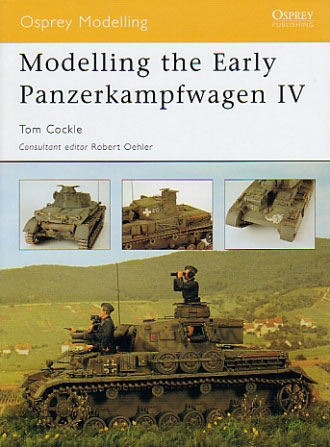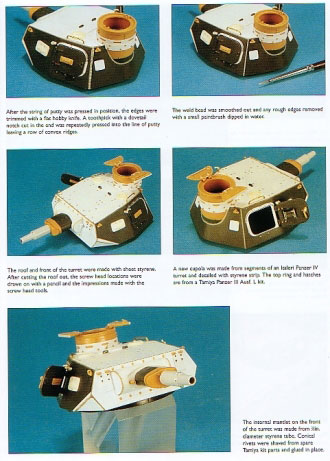|
|
|
|
Modelling the Early Panzerkampfwagen IV
Reviewed by Rob Baumgartner

Summary
| Publisher and Title | Osprey Modelling #26 Modelling the Early Panzerkampfwagen IV |
| Media and Contents: | 80 pages |
| Price: | USD$17.05 available online from Osprey's website |
| Review Type: | First Read |
| Advantages: | Clear photographs, easy to read informative text, competent models. |
| Disadvantages: | |
| Recommendation: | Recommended |
FirstLook
Many armour modellers will be familiar with the name Tom Cockle. He
has contributed articles to many magazines as well as authoring
several books.
This is his first Osprey title and
centres on modelling the early Panzerkampfwagen IV.
 The
usual format for this series is followed with 80 pages of text and
step by step photographs. The latter consists of nearly 200 colour
images with an additional page representing the paints used on the
vehicles themselves.
The
usual format for this series is followed with 80 pages of text and
step by step photographs. The latter consists of nearly 200 colour
images with an additional page representing the paints used on the
vehicles themselves.
The book concentrates on four
modelling projects. This is supplemented with a section on
materials, a brief description on the evolution of the early Panzer
IV, kits and accessories, and where to find further information on
the subject.
In the introduction, the author briefly describes the 75mm short
barrelled versions of this famous pedigree. He then lets the reader
know what tools he uses to detail the upcoming vehicles. Resin
moulding and soldering techniques are also discussed before we head
off into the “meat” of the book.
A Panzerkampfwagen IV Ausf. F is tackled first, this belonging to
the 5th Panzer Division in Russia, 1942. It is a project classified
with an “intermediate” skill level and combines the Tamiya Panzer IV
Ausf H kit and the MIG Productions PzIV F1 conversion set.
An Aber etched metal set and
Modelkasten tracks are added into the mix which provides even more
detail.
The numerous photographs reveal what has been done to get to the
final result but note that these are not meant to be an absolute
“step by step” guide. They are merely to show the reader what is
involved in the build and to help illustrate some of the techniques
offered.
It would take a book many more times this size to do otherwise.
The text is easy to read and provides many ideas to improve your
vehicle. Painting is all important to give the tank a realistic
appearance and this area is amply covered.
 Tamiya
kits are used again in the next instalment, this time to create a
Panzer IV Ausf. C from 6. Panzer Division in France 1940. A plethora
of accessories find their way into this build which is based on the
Flakpanzer IV Wirbelwind and Panzer IV Ausf D kits of the previously
mentioned manufacturer.
Tamiya
kits are used again in the next instalment, this time to create a
Panzer IV Ausf. C from 6. Panzer Division in France 1940. A plethora
of accessories find their way into this build which is based on the
Flakpanzer IV Wirbelwind and Panzer IV Ausf D kits of the previously
mentioned manufacturer.
There is much scratch building and
modification here to keep the reader entertained. As a result this
project is for the advanced modeller.
Even higher in the difficulty stakes is the subject of the next
section. The author tackles the Panzer IV Ausf. A and uses the same
two Tamiya kits from the previous chapter.
The usual abundance of accessories contributes to the detail here as
well as the skilful alteration of the basic parts.
The author shows us his method of widening the return rollers,
fabricating an upper hull and rebuilding the turret. Adding weld
beads can be an art in itself but Tom’s step by step approach makes
this task easy.
A lot of useful tips can be gleaned from this to help the modeller
improve other projects on their drawing board.
It’s good to see mention of the early war two tone paint scheme used
on these vehicles. This was documented for use on Panzers from
November 1938 to July 1940 and thus was used during the early stages
of World War II. The dunkelgrau and dunkelbraun patterns are very
hard to discern from black and white photos of the period which has
lead to the belief that all these Panzers were finished in overall
grau. Recent published research from a couple of leading authors in
the field has put this right.
The Armo Neubau-Fahrzeug rounds out the construction features and
being a multi media kit, very little is added to bring it up to the
standards maintained by the other examples. Thus the author devotes
some time to explaining how a simple vignette can be made to display
the finished model.
A gallery section concludes matters with an Ausf. D and F to provide
further stimulation for the viewer. Photos of the vehicle both
before and after painting reveal the extent of the added detail.
Conclusion
A recurring theme in these projects
is the amount (and expense) of the many and varied items used. This
book was not written with the intension of the reader acquiring
these goods and copying the projects verbatim. Besides, new kits
emerging on the market will make some of the conversions extraneous.
It was however designed to demonstrate the techniques the author
uses to detail the different projects on offer and pass these tips
on to the reader. The photographs show the salient points relating
to each version of Panzer IV and the reader can use these to attain
their own level of excellence.
Recommended to Panzer IV fans.
Thanks to
Osprey Publishing for the review sample.
